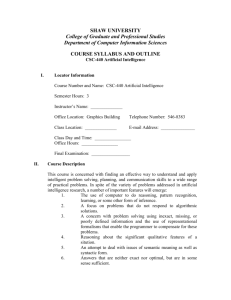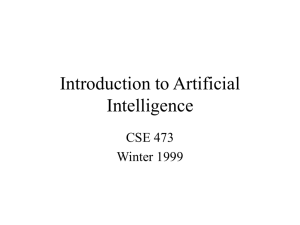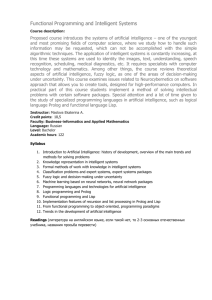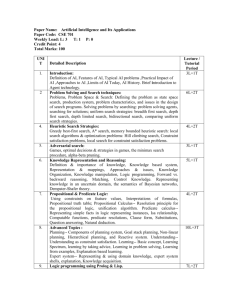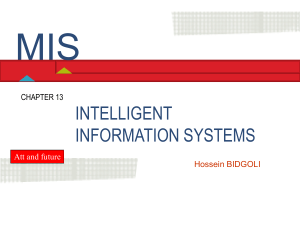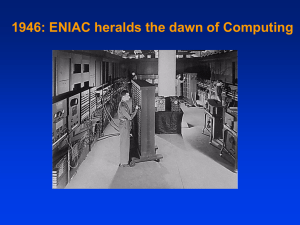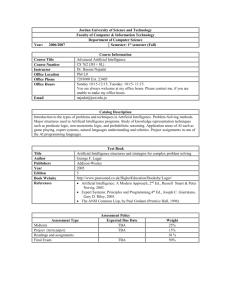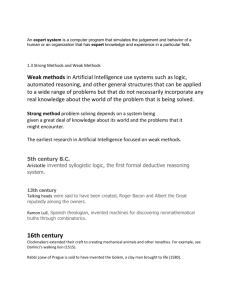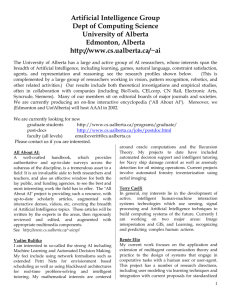Spring Semester 2004
advertisement
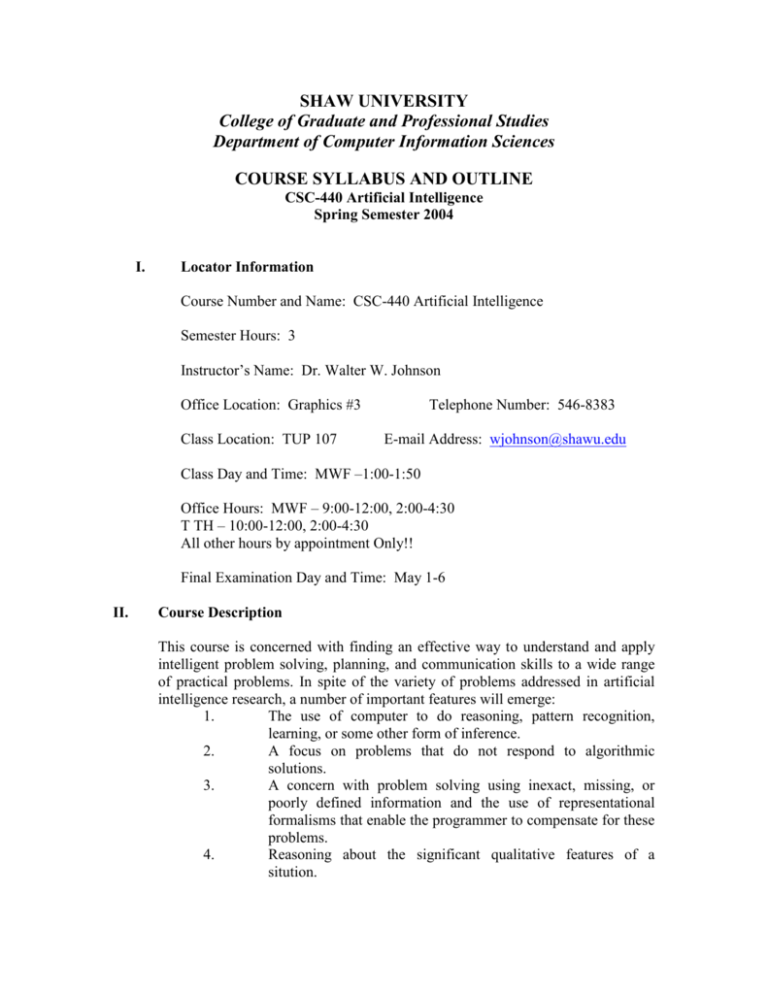
SHAW UNIVERSITY College of Graduate and Professional Studies Department of Computer Information Sciences COURSE SYLLABUS AND OUTLINE CSC-440 Artificial Intelligence Spring Semester 2004 I. Locator Information Course Number and Name: CSC-440 Artificial Intelligence Semester Hours: 3 Instructor’s Name: Dr. Walter W. Johnson Office Location: Graphics #3 Class Location: TUP 107 Telephone Number: 546-8383 E-mail Address: wjohnson@shawu.edu Class Day and Time: MWF –1:00-1:50 Office Hours: MWF – 9:00-12:00, 2:00-4:30 T TH – 10:00-12:00, 2:00-4:30 All other hours by appointment Only!! Final Examination Day and Time: May 1-6 II. Course Description This course is concerned with finding an effective way to understand and apply intelligent problem solving, planning, and communication skills to a wide range of practical problems. In spite of the variety of problems addressed in artificial intelligence research, a number of important features will emerge: 1. The use of computer to do reasoning, pattern recognition, learning, or some other form of inference. 2. A focus on problems that do not respond to algorithmic solutions. 3. A concern with problem solving using inexact, missing, or poorly defined information and the use of representational formalisms that enable the programmer to compensate for these problems. 4. Reasoning about the significant qualitative features of a sitution. 5. 6. 7. 8. An attempt to deal with issues of semantic meaning as well as syntactic form. Answers that are neither exact nor optimal, but are in some sense sufficient. The use of large amounts of domain specific knowledge in solving problems. The use of meta level knowledge effect more sophisticated control of problem solving strategies. The course brings you face-to-face with the most fundamental idea of Artificial Intelligence by why of computer programming strategies: The two most fundamental concerns of AI are knowledge representation and search. The first of these addresses the problem of capturing, in a formal language those things that are suitable for computer manipulation and the full range of knowledge related techniques required for intelligent behavior. The second, search, is a problem-solving technique that systematically explores a space of problem states. LISP and PROLOG will be used in this course. Mastery of LISP and PROLOG does not come easily, and for good reason. These logic languages may be used to examine different board configurations in a game or intermediate steps in a reasoning process. This space of alternatives solutions is then searched to find a final answer. You are about to begin the study of AI. It would be convenient if all the concepts behind programming could be explained using only natural language. Unfortunately, many aspects of programming require a high degree of precision, and natural language is not precise enough. In addition, we want to do more than just describe problems, we want to come up with a workable set of solution: we want to show how they are implemented. To fulfill these purposes, we use three different modes of expression: 1. For motivation and explanation, we use ordinary English. 2. When we need to be precise, we use the language of elementary mathematics. 3. When we need to display actual algorithms and implementations, we use the programming language LISP or PROLOG. II. Topics Artificial Intelligence Its roots and Scope Artificial Intelligence as representation and search. The predicate Calculus Structures and strategies for state space search Heuristic search Control and implementation of state space search Representation and Intelligence Knowledge representation Strong method problem solving Reasoning in uncertain situations Machine Learning Symbol based Machine learning Connectionist Machine learning Social and emergent Machine learning Tools for Symbolic Programming Simple Expressions Data Types Procedures Reduction Rules and Imperative Programming Reasoning About Procedures Parameter Passing Call-by-Reference Call-by-Value, Call-by-Name, and Call-by-Result Sub-Programs Fundamentals of Subprograms Design Issues for Subprograms Local Referencing Environments Parameter-Passing Methods Parameters that are Subprogram Names Overloaded Subprograms Generic Subprograms Separate and Independent Compilation Design Issues for Functions Accessing Nonlocal Environments User-Defined Overload Operators Coroutines Abstract Data Types Concept of Abstraction Encapsulation Parameterized Abstract Data Type Concurrency Exception Handling Evaluation: 3-4 Test Quizzes Final Exam Project 30% 10% 20% 40% Ethics: Any student cheating (giving or receiving information) on daily work, homework, or test will be given a grade of zero on that assignment or test. This zero grade will not be dropped. The second offense will result in immediate suspension from the class. The Project: You are to follow the project description given in the text chapters 1-11. The final outcome is that you will have built your own Artificial Intelligent machine. Attendance Policy: 1. Students who miss classes are responsible for subject matter covered, any announcements regarding quiz or test or any other relevant matter, during their absence. 2. More than three (3) (if class meets three (3) days a week or equivalent such as a class that meets 1.5 hours twice a week) or two (2) (if class meets two (2) days a week) unexcused absences may result in failure or being dropped from the class
